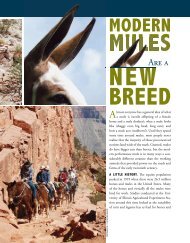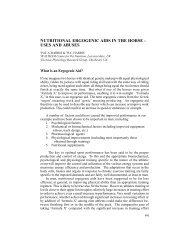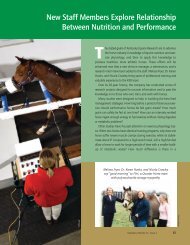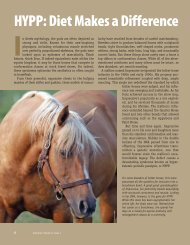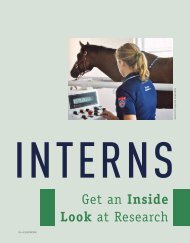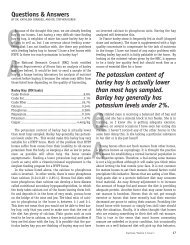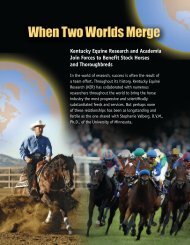The Management of Tying-Up in Sport Horses - Kentucky Equine ...
The Management of Tying-Up in Sport Horses - Kentucky Equine ...
The Management of Tying-Up in Sport Horses - Kentucky Equine ...
Create successful ePaper yourself
Turn your PDF publications into a flip-book with our unique Google optimized e-Paper software.
MANAGEMENT OF TYING-UP IN SPORT HORSESDietary management. A nutritionally balanced diet with appropriate caloric <strong>in</strong>take and adequatevitam<strong>in</strong>s and m<strong>in</strong>erals is the core element <strong>of</strong> treat<strong>in</strong>g all forms <strong>of</strong> ty<strong>in</strong>g-up. As with any horse, forage isrecommended at a rate <strong>of</strong> 1.5-2% <strong>of</strong> body weight. In general, grass hay is preferable to alfalfa hay. Dietswith a restricted amount <strong>of</strong> starch and sugar and supplemental calories supplied with fat are the basisfor dietary management. For Thoroughbreds and Standardbreds with RER, the challenge is supply<strong>in</strong>g anadequate amount <strong>of</strong> calories <strong>in</strong> a highly palatable feed to meet their daily energy demands. Out <strong>of</strong> thetotal daily calories required, it is recommended that less than 20% digestible energy (DE) be supplied bystarch and at least 15% be supplied by fat. Controlled experimental studies us<strong>in</strong>g Thoroughbreds withRER show that serum CK activity is significantly lower when horses are fed a specially formulated highfat,low-starch feed rather than an isocaloric amount <strong>of</strong> high-starch gra<strong>in</strong> (MacLeay et al., 2000;McKenzie et al., 2003). Given the close relationship between nervousness and RER, assuag<strong>in</strong>g anxietyand excitability by reduc<strong>in</strong>g dietary starch and <strong>in</strong>creas<strong>in</strong>g dietary fat may decrease susceptibility bymak<strong>in</strong>g these horses calmer prior to exercise. To <strong>in</strong>crease a horse’s energy dur<strong>in</strong>g the race, some racehorsetra<strong>in</strong>ers prefer to supplement with a titrated amount <strong>of</strong> gra<strong>in</strong> three days prior to a race if horsesare on a low-starch, high-fat feed.For PSSM horses, the challenge can be to provide adequate fat for energy metabolism while prevent<strong>in</strong>gexcessive weight ga<strong>in</strong>. If horses are overweight, reduc<strong>in</strong>g caloric <strong>in</strong>take by us<strong>in</strong>g a graz<strong>in</strong>g muzzle,restrict<strong>in</strong>g hay to 1.5% <strong>of</strong> body weight and provid<strong>in</strong>g a vitam<strong>in</strong>/m<strong>in</strong>eral ration balancer are recommended.Add<strong>in</strong>g excessive calories <strong>in</strong> the form <strong>of</strong> fat to an obese horse is <strong>in</strong>advisable. Until horses are <strong>of</strong>normal weight, fat metabolism can be enhanced by rid<strong>in</strong>g horses after a 5-8 hour fast as a means to elevateplasma free fatty acids. Once a horse has achieved the desired body weight, low-starch andlow-sugar feeds comb<strong>in</strong>ed with dietary fat can be <strong>in</strong>troduced. <strong>The</strong> starch and sugar content <strong>of</strong> the diet <strong>of</strong>PSSM horses needs to be managed more str<strong>in</strong>gently than for RER. Owners report that this type <strong>of</strong> dietimproves cl<strong>in</strong>ical signs <strong>of</strong> muscle pa<strong>in</strong>, stiffness, and exercise tolerance <strong>in</strong> draft horses, Warmbloods,Quarter <strong>Horses</strong>, and horses <strong>of</strong> other breeds with PSSM when comb<strong>in</strong>ed with the recommended exerciseprogram. Dietary change appears to have lesser impact on alleviat<strong>in</strong>g gait changes such as shivers (Huntet al., 2008). In Quarter <strong>Horses</strong> with PSSM, provid<strong>in</strong>g less than 10% <strong>of</strong> daily digestible energy as dietarystarch and 13% <strong>of</strong> daily digestible energy as dietary fat dur<strong>in</strong>g a six-week trial resulted <strong>in</strong> normal serumCK activity four hours post exercise (Ribeiro et al., 2004). <strong>The</strong> beneficial effect <strong>of</strong> the low-starch, high-fatdiet used <strong>in</strong> this study (Re-Leve®) was believed to be the result <strong>of</strong> less glucose uptake <strong>in</strong>to muscle cellsand provision <strong>of</strong> more plasma free fatty acids for use <strong>in</strong> muscle fibers dur<strong>in</strong>g aerobic exercise. Quarter<strong>Horses</strong> naturally have very little lipid stored with<strong>in</strong> muscle fibers and provision <strong>of</strong> free fatty acids mayovercome the disruption <strong>in</strong> energy metabolism that appears to occur dur<strong>in</strong>g aerobic exercise. <strong>The</strong> addition<strong>of</strong> fat alone is not beneficial and an exercise program must be <strong>in</strong>stituted for PSSM horses to showcl<strong>in</strong>ical improvement. Based on anecdotal experience, some authors recommend that >20% <strong>of</strong> dailycaloric <strong>in</strong>take be supplied by fat (0.5 kg <strong>of</strong> fat). <strong>The</strong>re are no controlled studies that support the need t<strong>of</strong>eed every PSSM horse one pound <strong>of</strong> fat (3 cups or more <strong>of</strong> oil), and there are controlled studies to showPSSM horses can consume less fat and have normal CK activity (Borgia et al., 2010). In the author’s experience,there is a great deal <strong>of</strong> variation <strong>in</strong> <strong>in</strong>dividual needs for fat supplementation and this should bebalanced with the horse’s weight.889
MANAGEMENT OF TYING-UP IN SPORT HORSESSeveral well-balanced, low-starch/high-fat commercial diets are suitable for horses with RER andPSSM. Some commercial feeds meet the recommended nutritional needs <strong>of</strong> RER and PSSM horses <strong>in</strong> onepelleted ration and have been thoroughly evaluated (Re-Leve®). <strong>The</strong>se feeds typically conta<strong>in</strong> 10-14%fat by weight and less than 20% starch or nonstructural carbohydrate (NSC) by weight. Some feed companies<strong>of</strong>fer similar nutritional content by blend<strong>in</strong>g two or more manufactured feeds or bysupplement<strong>in</strong>g with oils or rice bran. Palatability <strong>of</strong> pelleted feeds is usually higher than feeds conta<strong>in</strong><strong>in</strong>gpour-on oils or loose rice bran. At present, the NSC content <strong>of</strong> equ<strong>in</strong>e feed products is not listed onthe feed tag, and consultation with the feed manufacturer is necessary to obta<strong>in</strong> this <strong>in</strong>formation.Nutritional support is available through most feed manufacturers <strong>in</strong> design<strong>in</strong>g an appropriate diet. Notall <strong>of</strong> these feeds are equally effective. Hay with an NSC content <strong>of</strong> 12% or less is recommended forPSSM horses.Medication. Tranquilizers may be <strong>of</strong> value <strong>in</strong> treat<strong>in</strong>g excitable horses prone to RER. Dantrolene sodiumis a medication that acts to decrease release <strong>of</strong> calcium from the calcium release channel <strong>in</strong> skeletalmuscle. When given to RER horses 60 to 90 m<strong>in</strong>utes prior to exercise, dantrolene appears to attenuatemuscle damage but is expensive to use on a cont<strong>in</strong>uous basis. Phenyto<strong>in</strong> acts on a number <strong>of</strong> ion channelswith<strong>in</strong> muscle and nerves <strong>in</strong>clud<strong>in</strong>g sodium and calcium channels and has also been used as atherapeutic agent to prevent RER. Some mares appear to exhibit signs <strong>of</strong> ER dur<strong>in</strong>g estrus, and it maywell be <strong>of</strong> benefit <strong>in</strong> these horses to suppress estrus behavior us<strong>in</strong>g progesterone <strong>in</strong>jections.Testosterone and anabolic steroids are used at racetracks to prevent signs <strong>of</strong> RER, but the efficacy has notbeen evaluated.To date there are no tested management strategies for horses with MH, although dantrolene seemslike a reasonable but expensive approach. <strong>Horses</strong> with both MH and PSSM have been shown to respondto high-fat, low-starch diets although their response is not as favorable as horses with PSSM alone(McCue et al., 2009b).ConclusionManag<strong>in</strong>g muscle disorders <strong>in</strong> sport horses <strong>in</strong>volves the identification <strong>of</strong> the specific cause <strong>of</strong> ty<strong>in</strong>gup,rest, selection <strong>of</strong> medications (to reduce pa<strong>in</strong>, address deficiencies, or counteract diseasemechanisms), diet regimes designed to counteract any metabolic deficiencies, rehabilitation therapy,and gradual re<strong>in</strong>troduction <strong>of</strong> exercise up to the <strong>in</strong>tended performance. Many advances have been madeover the course <strong>of</strong> the last 30 years <strong>in</strong> identify<strong>in</strong>g specific causes for ty<strong>in</strong>g-up, develop<strong>in</strong>g new diagnostictests, and research<strong>in</strong>g specific diet and exercise programs to decrease recurrence <strong>of</strong> muscle pa<strong>in</strong>. <strong>The</strong>future likely holds identification <strong>of</strong> new forms <strong>of</strong> ty<strong>in</strong>g-up, development <strong>of</strong> more genetic tests to diagnosespecific causes, and cont<strong>in</strong>ued evolution <strong>of</strong> dietary management and exercise regimes tailored to<strong>in</strong>dividual cases.Conflict <strong>of</strong> <strong>in</strong>terest statement: Drs. Valberg, Mickelson, and McCue own the license for PSSM test<strong>in</strong>gand receive sales <strong>in</strong>come from its use. <strong>The</strong>ir f<strong>in</strong>ancial and bus<strong>in</strong>ess <strong>in</strong>terests have been reviewed andmanaged by the University <strong>of</strong> M<strong>in</strong>nesota <strong>in</strong> accordance with its conflict <strong>of</strong> <strong>in</strong>terest policies.990
MANAGEMENT OF TYING-UP IN SPORT HORSESREFERENCESAleman, M., R.J. Brosnan, D.C. Williams, R.A. Lecouteur, A. Imai, B.R. Tharp, and E.P. Steffey. 2005.Malignant hyperthermia <strong>in</strong> a horse anesthetized with halothane. J. Vet. Intern. Med. 19:363-366.Aleman, M. , J.E. Nieto, and K.G. Magdesian. 2009. Malignant hyperthermia associated with ryanod<strong>in</strong>ereceptor 1 (C7360G) mutation <strong>in</strong> Quarter <strong>Horses</strong>. J. Vet. Intern. Med. 23:329-334.Aleman, M., J. Riehl, B.M. Aldridge, R.A. Lecouteur, J.L. Stott, and I.N. Pessah. 2004. Association <strong>of</strong> amutation <strong>in</strong> the ryanod<strong>in</strong>e receptor 1 gene with equ<strong>in</strong>e malignant hyperthermia. Muscle Nerve30:356-365.Annandale, E.J., S.J. Valberg, and B. Essen-Gustavsson. 2005. Effects <strong>of</strong> submaximal exercise on aden<strong>in</strong>enucleotide concentrations <strong>in</strong> skeletal muscle fibers <strong>of</strong> horses with polysaccharide storage myopathy.Am. J. Vet. Res. 66:839-845.Annandale, E.J., S.J. Valberg, J.R. Mickelson, and E.R. Seaquist. 2004. Insul<strong>in</strong> sensitivity and skeletalmuscle glucose transport <strong>in</strong> horses with equ<strong>in</strong>e polysaccharide storage myopathy. Neuromuscul.Disord. 14:666-674.Borgia, L.A., S.J. Valberg, M.E. McCue, J.D. Pagan, and C.R. Roe. 2010. Effect <strong>of</strong> dietary fats with odd oreven numbers <strong>of</strong> carbon atoms on metabolic response and muscle damage with exercise <strong>in</strong> QuarterHorse-type horses with type 1 polysaccharide storage myopathy. Am. J. Vet. Res. 71:326-336.Carlson, G.P. 1985. Medical problems associated with protracted heat and work stress <strong>in</strong> horses. In: Proc.Fifth Ann. Association <strong>of</strong> Equ<strong>in</strong>e <strong>Sport</strong>s Medic<strong>in</strong>e. Reno, NV. pp. 84-99.Cole, F.L., D.J. Mellor, D.R. Hodgson, and S.W. Reid. 2004. Prevalence and demographic characteristics <strong>of</strong>exertional rhabdomyolysis <strong>in</strong> horses <strong>in</strong> Australia. Vet.Rec. 155, 625-630.Coll<strong>in</strong>der, E., A. L<strong>in</strong>dholm, and M. Rasmuson. 1997. Genetic markers <strong>in</strong> Standardbred trotters susceptibleto the rhabdomyolysis syndrome. Equ<strong>in</strong>e Vet. J. 29:117-120.De La Corte, F.D., S.J. Valberg, J.M. MacLeay, and J.R. Mickelson. 2002. Developmental onset <strong>of</strong> polysaccharidestorage myopathy <strong>in</strong> four Quarter Horse foals. J. Vet. Intern. Med. 16:581-587.Divers, T.J., H.O. Mohammed, J.F. Cumm<strong>in</strong>gs, B.A. Valent<strong>in</strong>e, A. De Lahunta, C.A. Jackson, and B.A.Summers. 1994. Equ<strong>in</strong>e motor neuron disease: F<strong>in</strong>d<strong>in</strong>gs <strong>in</strong> 28 horses and proposal <strong>of</strong> a pathophysiologicalmechanism for the disease. Equ<strong>in</strong>e Vet. J. 26:409-415.191
MANAGEMENT OF TYING-UP IN SPORT HORSESDranchak, P.K., S.J. Valberg, G.W. Onan, E.M. Gallant, M.M. B<strong>in</strong>ns, J.E. Sw<strong>in</strong>burne, and J.R. Mickelson.2006. Exclusion <strong>of</strong> l<strong>in</strong>kage <strong>of</strong> the RYR1, CACNA1S, and ATP2A1 genes to recurrent exertional rhabdomyolysis<strong>in</strong> Thoroughbreds. Am. J. Vet. Res. 67:1395-1400.Dranchak, P.K., S.J. Valberg, G.W. Onan, E.M. Gallant, J.M. MacLeay, E.C. McKenzie, F.D. De La Corte, K.Ekenstedt, and J.R. Mickelson. 2005. Inheritance <strong>of</strong> recurrent exertional rhabdomyolysis <strong>in</strong>Thoroughbreds. J. Am. Vet. Med. Assoc. 227:762-767.Firshman, A.M., J.D. Baird, and S.J. Valberg. 2005. Prevalences and cl<strong>in</strong>ical signs <strong>of</strong> polysaccharide storagemyopathy and shivers <strong>in</strong> Belgian draft horses. J. Am. Vet. Med. Assoc. 227:1958-1964.Fraunfelder, H.C., P.D. Rossdale, and S.W. Rickets. 1986. Changes <strong>in</strong> serum muscle enzyme levels <strong>in</strong> associatedwith tra<strong>in</strong><strong>in</strong>g schedules and stages <strong>of</strong> oestrus cycle <strong>in</strong> thoroughbred racehorses. Equ<strong>in</strong>e Vet. J.18:371-374.Freestone, J.F., and G.R. Carlson. 1991. Muscle disorders <strong>in</strong> the horse: A retrospective study. Equ<strong>in</strong>e Vet. J.23:86-90.Harris, P.A. 1990. An outbreak <strong>of</strong> the equ<strong>in</strong>e rhabdomyolysis syndrome <strong>in</strong> a rac<strong>in</strong>g yard. Vet. Rec.127:468-470.Harris, P.A. 1991. <strong>The</strong> equ<strong>in</strong>e rhabdomyolysis syndrome <strong>in</strong> the United K<strong>in</strong>gdom: Epidemiological andcl<strong>in</strong>ical descriptive <strong>in</strong>formation. Br. Vet. J. 147:373-384.Harris, P.A., D.H. Snow, T.R. Greet, and P.D. Rossdale. 1990. Some factors <strong>in</strong>fluenc<strong>in</strong>g plasma AST/CKactivities <strong>in</strong> Thoroughbred racehorses. Equ<strong>in</strong>e Vet. J. Suppl 66-71.Hunt, L.M., S.J. Valberg, K. Steffenhagen, and M.E. McCue. 2008. An epidemiological study <strong>of</strong>myopathies <strong>in</strong> Warmblood horses. Equ<strong>in</strong>e Vet. J. 40:171-177.Lentz, L.R., S.J. Valberg, E.M. Balog, J.R. Mickelson, and E.M. Gallant. 1999. Abnormal regulation <strong>of</strong>muscle contraction <strong>in</strong> horses with recurrent exertional rhabdomyolysis. Am. J. Vet. Res. 60:992-999.Lentz, L.R., S.J. Valberg, L.V. Herold, G.W. Onan, J.R. Mickelson, and E.M. Gallant. 2002. Myoplasmic calciumregulation <strong>in</strong> myotubes from horses with recurrent exertional rhabdomyolysis. Am. J. Vet. Res.63:1724-1731.L<strong>in</strong>dholm, A., and K. Piehl. 1974. Fibre composition, enzyme activity and concentrations <strong>of</strong> metabolitesand electrolytes <strong>in</strong> muscles <strong>of</strong> Standardbred horses. Acta. Vet. Scand. 15:287-309.192
MANAGEMENT OF TYING-UP IN SPORT HORSESMacLeay, J.M., S.A. Sorum, S.J. Valberg, W.E. Marsh, and M.D. Sorum. 1999a. Epidemiologic analysis <strong>of</strong>factors <strong>in</strong>fluenc<strong>in</strong>g exertional rhabdomyolysis <strong>in</strong> Thoroughbreds. Am. J. Vet. Res. 60:1562-1566.MacLeay, J.M., S.J. Valberg, J.D. Pagan, F. De La Corte, J. Roberts, J. Billstrom, J. McG<strong>in</strong>nity, and H. Kaese.1999b. Effect <strong>of</strong> diet on Thoroughbred horses with recurrent exertional rhabdomyolysis perform<strong>in</strong>g astandardised exercise test. Equ<strong>in</strong>e Vet. J. Suppl 30:458-462.MacLeay, J.M., S.J. Valberg, J.D. Pagan, J.L. Xue, F.D. De La Corte, and J. Roberts. 2000. Effect <strong>of</strong> ration andexercise on plasma creat<strong>in</strong>e k<strong>in</strong>ase activity and lactate concentration <strong>in</strong> Thoroughbred horses withrecurrent exertional rhabdomyolysis. Am. J. Vet. Res. 61:1390-1395.McCue, M.E., A.G. Armien, M. Lucio, J.R. Mickelson, and S.J. Valberg. 2009a. Comparative skeletal musclehistopathologic and ultrastructural features <strong>in</strong> two forms <strong>of</strong> polysaccharide storage myopathy <strong>in</strong>horses. Vet. Pathol. 46:1281-1291.McCue, M.E., W.P. Ribeiro, and S.J. Valberg. 2006. Prevalence <strong>of</strong> polysaccharide storage myopathy <strong>in</strong>horses with neuromuscular disorders. Equ<strong>in</strong>e Vet. J. Suppl. 340-344.McCue, M.E., and S.J. Valberg. 2007. Estimated prevalence <strong>of</strong> polysaccharide storage myopathy amongovertly healthy Quarter <strong>Horses</strong> <strong>in</strong> the United States. Am. J. Vet. Res. 231:746-750.McCue, M.E., S.J. Valberg, M. Jackson, L. Borgia, M. Lucio, and J.R. Mickelson. 2009b. Polysaccharide storagemyopathy phenotype <strong>in</strong> Quarter Horse-related breeds is modified by the presence <strong>of</strong> an RYR1mutation. Neuromuscul. Disord. 19:37-43.McCue, M.E., S.J. Valberg, M. Lucio, and J.R. Mickelson. 2008a. Glycogen Synthase 1 (GYS1) mutation <strong>in</strong>diverse breeds with polysaccharide storage myopathy. J Vet. Intern. Med. 22:1228-1233.McCue, M.E., S.J. Valberg, M.B. Miller, C. Wade, S. DiMauro, H.O. Akman, and J.R. Mickelson. 2008b.Glycogen synthase (GYS1) mutation causes a novel skeletal muscle glycogenosis. Genomics91:458-466.McGowan, C.M., T. Fordham, and R.M. Christley. 2002a. Incidence and risk factors for exertional rhabdomyolysis<strong>in</strong> Thoroughbred racehorses <strong>in</strong> the United K<strong>in</strong>gdom. Vet. Rec. 151:623-626.McGowan, C.M., R.E. Posner, and R.M. Christley. 2002b. Incidence <strong>of</strong> exertional rhabdomyolysis <strong>in</strong> polohorses <strong>in</strong> the USA and the United K<strong>in</strong>gdom <strong>in</strong> the 1999/2000 season. Vet. Rec. 150:535-537.McKenzie, E.C., S.J. Valberg, S.M. Godden, J.D. Pagan, J.M. MacLeay, R.J. Geor, and G.P. Carlson. 2003.Effect <strong>of</strong> dietary starch, fat, and bicarbonate content on exercise responses and serum creat<strong>in</strong>e k<strong>in</strong>aseactivity <strong>in</strong> equ<strong>in</strong>e recurrent exertional rhabdomyolysis. J. Vet. Intern. Med. 17:693-701.193




